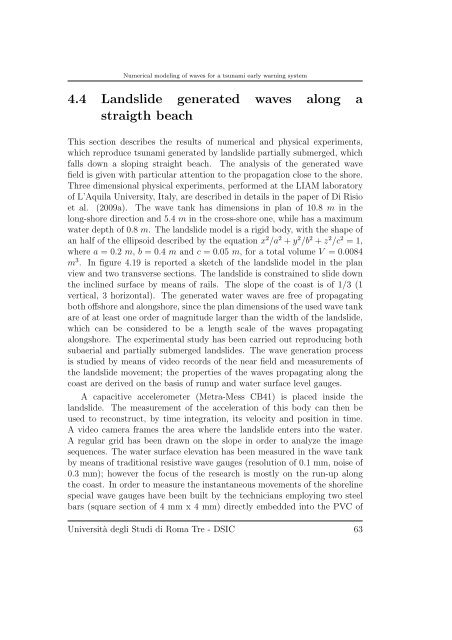Numerical modeling of waves for a tsunami early warning system
Numerical modeling of waves for a tsunami early warning system
Numerical modeling of waves for a tsunami early warning system
Create successful ePaper yourself
Turn your PDF publications into a flip-book with our unique Google optimized e-Paper software.
<strong>Numerical</strong> <strong>modeling</strong> <strong>of</strong> <strong>waves</strong> <strong>for</strong> a <strong>tsunami</strong> <strong>early</strong> <strong>warning</strong> <strong>system</strong><br />
4.4 Landslide generated <strong>waves</strong> along a<br />
straigth beach<br />
This section describes the results <strong>of</strong> numerical and physical experiments,<br />
which reproduce <strong>tsunami</strong> generated by landslide partially submerged, which<br />
falls down a sloping straight beach. The analysis <strong>of</strong> the generated wave<br />
field is given with particular attention to the propagation close to the shore.<br />
Three dimensional physical experiments, per<strong>for</strong>med at the LIAM laboratory<br />
<strong>of</strong> L’Aquila University, Italy, are described in details in the paper <strong>of</strong> Di Risio<br />
et al. (2009a). The wave tank has dimensions in plan <strong>of</strong> 10.8 m in the<br />
long-shore direction and 5.4 m in the cross-shore one, while has a maximum<br />
water depth <strong>of</strong> 0.8 m. The landslide model is a rigid body, with the shape <strong>of</strong><br />
an half <strong>of</strong> the ellipsoid described by the equation x 2 /a 2 + y 2 /b 2 + z 2 /c 2 =1,<br />
where a =0.2 m, b =0.4 m and c =0.05 m, <strong>for</strong> a total volume V =0.0084<br />
m 3 . In figure 4.19 is reported a sketch <strong>of</strong> the landslide model in the plan<br />
view and two transverse sections. The landslide is constrained to slide down<br />
the inclined surface by means <strong>of</strong> rails. The slope <strong>of</strong> the coast is <strong>of</strong> 1/3 (1<br />
vertical, 3 horizontal). The generated water <strong>waves</strong> are free <strong>of</strong> propagating<br />
both <strong>of</strong>fshore and alongshore, since the plan dimensions <strong>of</strong> the used wave tank<br />
are <strong>of</strong> at least one order <strong>of</strong> magnitude larger than the width <strong>of</strong> the landslide,<br />
which can be considered to be a length scale <strong>of</strong> the <strong>waves</strong> propagating<br />
alongshore. The experimental study has been carried out reproducing both<br />
subaerial and partially submerged landslides. The wave generation process<br />
is studied by means <strong>of</strong> video records <strong>of</strong> the near field and measurements <strong>of</strong><br />
the landslide movement; the properties <strong>of</strong> the <strong>waves</strong> propagating along the<br />
coast are derived on the basis <strong>of</strong> runup and water surface level gauges.<br />
A capacitive accelerometer (Metra-Mess CB41) is placed inside the<br />
landslide. The measurement <strong>of</strong> the acceleration <strong>of</strong> this body can then be<br />
used to reconstruct, by time integration, its velocity and position in time.<br />
A video camera frames the area where the landslide enters into the water.<br />
A regular grid has been drawn on the slope in order to analyze the image<br />
sequences. The water surface elevation has been measured in the wave tank<br />
by means <strong>of</strong> traditional resistive wave gauges (resolution <strong>of</strong> 0.1 mm, noise <strong>of</strong><br />
0.3 mm); however the focus <strong>of</strong> the research is mostly on the run-up along<br />
the coast. In order to measure the instantaneous movements <strong>of</strong> the shoreline<br />
special wave gauges have been built by the technicians employing two steel<br />
bars (square section <strong>of</strong> 4 mm x 4 mm) directly embedded into the PVC <strong>of</strong><br />
Università degli Studi di Roma Tre - DSIC 63

















